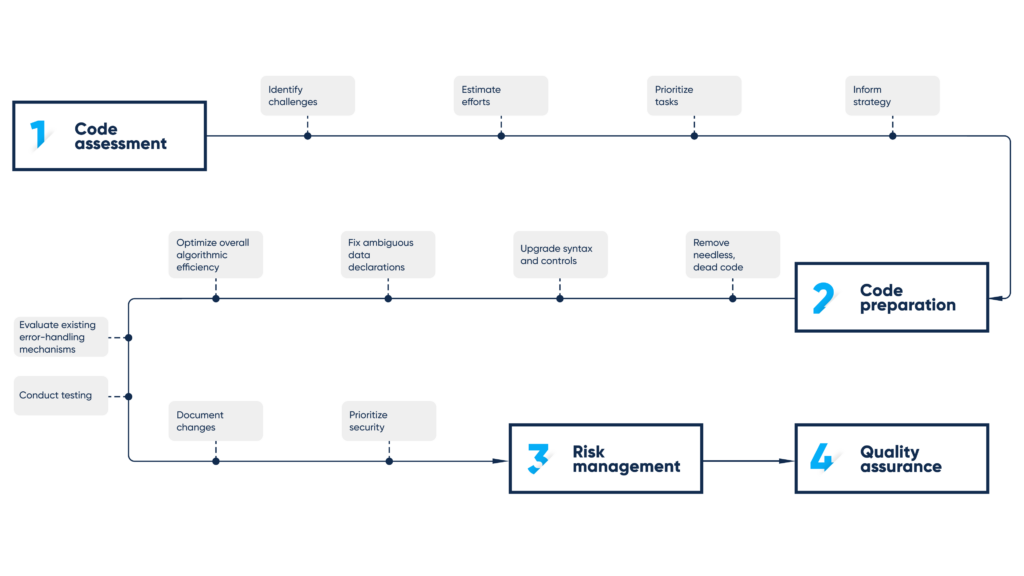VB6 to .NET migration: Key considerations

Business leaders still utilizing legacy applications built upon Visual Basic 6 (VB6) should consider .NET migration. The platform’s mainline support was discontinued in 2008, which means your applications structured around this outdated programming language are running under limitations and will need workarounds to function properly under Windows 8.1/10/11.
VB6 to .NET conversion: Proven tips to maintain your efficiency

Tip 1: Code assessment
Identify challenges
A thought-out VB6 to .NET migration approach begins with carefully identifying challenges before converting.
Code assessment allows engineers to identify potential challenges and roadblocks before they even manifest. By understanding the intricacies of the existing codebase, the team can anticipate potential issues and create effective strategies to address those proactively.
Estimate efforts
Another thing, VB6 to .NET migration strategy planning also means estimating efforts.
Codebase assessment provides engineers with insights into scope and complexities of the prospective project. It enables the team to estimate required efforts, including skills, cost, time, documentation, maintenance, stakeholder engagement, and more.
Prioritize tasks
Legacy assessment enables thought-out task prioritization, which means more informed resource allocation. This helps focus efforts on the critical areas of the examined codebase that require immediate attention – high-risk components, outdated dependencies, and similar.
Inform strategy
Application assessment guides decisions on approaches, technology stack, preferred methodologies, and more. This means, the strategy can be accurately tailored to address the challenges being identified during discovery, thus ensuring smooth conversion.
Tip 2: Code preparation
Remove needless, dead code
- Automatic assessment: Systematic analysis using specialized automated tools to identify and catalog potentially unused code segments in the VB6 application
- Manual assessment: Human validation of findings before elimination to ensure accurate identification of irrelevant VB6 application code segments, considering context, business logic, and dependencies
Upgrade syntax and controls
- Syntax upgrade: The identification and upgrade of syntax, for example the replacement of constructs and update of conditional compilation (statements)
- Control upgrade: The resolution of control-related compatibility problems, for example the migration of VB5 Common Controls to equivalents like ADO data control or MsComCtl.ocx and MsComCt2.ocx
Fix ambiguous data declarations
To fix data declarations when approaching VB6 to .NET migration involves accelerating application robustness by enforcing variable declaration and providing type declarations by using either “As Integer” or “As String”. This eliminates potential ambiguity, naturally enabling smoother migration.
Optimize overall algorithmic efficiency
To optimize algorithmic efficiency when performing VB6 to NET migration includes refining fundamental logic. This empowers software developers to identify and address existing bottlenecks, thus facilitating the efficiency of the legacy application being converted.
Evaluate existing error-handling mechanisms
Take time to review the existing error-handling mechanisms to align them with the current best practices. Implement structured error-handling constructs to ensure robust handling of exceptions as well as refined failure modes.
Conduct testing
- Unit testing: First, cover the code with unit testing to validate the functionality of individual application components
- Integration testing: Secondly, perform integration testing to ensure the components interact correctly
- System Testing: Lastly, validate the entire system’s behavior through rigorous system testing to catch any regressions and issues that might arise during the migration
Document changes
Systematically record code modifications made during VB6 migration to .NET to ensure 100% transparency, improved communication and collaboration, enhanced maintainability, and better knowledge transfer.
Prioritize security
Identify and address vulnerabilities in the legacy codebase when handling VB6 migration to NET by performing security audits, updating protocols, validating inputs and reinforcing access controls.
Tip 3: Risk management
Another recommendation – don’t underestimate risk mitigation when approaching VB6 to .NET conversion.
A quite generic statement mentioned everywhere, but nonetheless, when performing VB6 to .NET conversion, your team shouldn’t neglect risk management, as this might cause reputational and financial damage.
In order to diminish:
- Cost and time overruns
- Skills and resource constraints
- Data loss
- Data corruption and duplication
- Security vulnerabilities
- Compatibility issues
- Functional regression
- Performance degradation
Your team should cover:
- Risk identification and analysis
- Risk mitigation strategy planning
- Security practices – data encryption, access controls, data anonymization, data backup and recovery
- Thorough testing
- Performance optimization
- Performance monitoring and review
Tip 4: Quality assurance
Quality assurance is critical to ensure the client is not:
- Obtaining an unreliable application not meeting user expectations and requirements
- Experiencing unjustified support expenses
- Missing opportunities for further business growth and competitiveness
- Facing penalties and liabilities associated with regulatory non-compliance
Quality assurance is performed to enable:
- Data integrity – when you migrate VB6 to .NET, quality assurance is an important stage to eliminate data loss, corruption, duplication, and inconsistencies, thereby ensuring uninterrupted operations
- Risk management – when you migrate VB6 to NET, quality assurance helps identify and mitigate security and compatibility issues, functional regression, performance degradation, as well as other common problems that have adverse impact on overall business efficiency
- Application functionality – QA practices help identify and address any defects to ensure the application is behaving as expected and maintains its functionality after migration
- Regulatory compliance – mentioned practices are implemented to ensure the application is meeting industry standards, regulatory requirements, best practices, and other domain-specific guidelines
Functional equivalence comes foremost: First migrate, then rewrite
By prioritizing functional equivalence, business leaders can maintain greater control over scope and timeline without disrupting business operation.
The decision to migrate typically indicates that the existing application carries worth for the client company. The embedded business logic and rules are often the backbone of the client’s operations, and thus it’s critical to preserve those when approaching migration.
It might be tempting to use the migration to rewrite separate parts of the legacy application for modernization, but this can cause time-to-market delays, cost overruns, technical complexity, resource constraints, and more. After handling the migration, there surely will be many opportunities to optimize and extend the application without causing unnecessary complications.
How we can help
Abto Software is there to help business leaders move towards market dominance by handling VB6 migration. Our engineers cover everything from initial code assessment to successful VB6 migration and finalization, making sure your applications are running as expected.
Forget about limited functionality and scalability, security vulnerabilities, compatibility issues, and insufficient business performance.
Our services:
- Business analysis and consulting
- Project setup and kick-off
- Code migration
- Code finalization
- Acceptance testing and improvement
- Quality assurance and deployment
Your benefits:
- Higher performance and efficiency
- Expanded functionality and scalability
- Improved security through updates and patches
- Enhanced compatibility across platforms and devices
- Long-term support and maintenance
- Cloud compatibility
Abto Software – your trusted VB6 migration partner handling technical challenges to fuel your growth.


